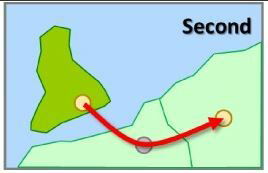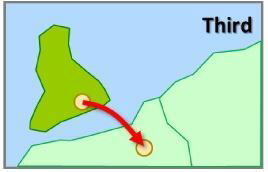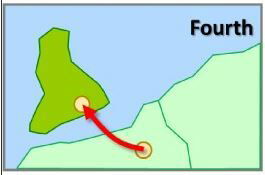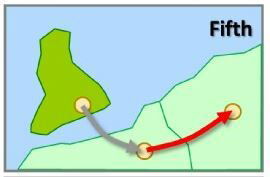This chapter covers additional information about route traffic rights and "freedoms of the air" and how they are modeled in AirwaySim. It does not cover any actual game functions or their usage so reading this is optional.
Background And History
Up until recently airline traffic rights, including route capacities and ticket prices, have been heavily restricted and controlled by bilateral agreements negotiated by governments of any given two countries. Recently, the trend has been towards liberalisation of air traffic and various "open skies" agreements between groups of countries.
Early aviation conventions meant each country had full control over its airspace and a prior permission was required for all foreign aircraft operations in and over the country. After WWII many nations had set up national airlines to protect their economic interests and for national pride. This led to increased protectionism in the aviation sector. So, to control and agree rules about air transportation, bilateral agreements were formed between various countries. To date there have been some 3000 bilateral agreements between countries.
Once establised, a bilateral air services agreement, it allowed the airlines of both states to launch commercial flights between the countries. The bilateral agreements covered allowed city-pairs that can be flown and also set restrictions on offered seat capacity, ticket pricing and weekly flight frequencies. Most of the traffic between various countries in the world is still today covered by these agreements.
Recently the air traffic has been liberated by removing, for example, the city-pair traffic right restrictions by various "open skies" agreements. One of the recent and notable ones was the open skies agreement inside the European Union which allows any EU carrier to fly any route inside the union member states.
In AirwaySim the model of the traffic rights is simpler since covering the scope of bilateral agreements over the course of last 60 years globally is impossible. In the simulation we have chosen a basic global "open skies" policy meaning that any airline can fly (and overfly) between any two countries (given that route departs or ends in the home country) and there are no pricing or capacity restrictions (apart from what is set in Game Rules regarding Fair Play). "National airlines" are also not modeled and each airline represents a private venture, so the national interests of airlines are not to be protected either. The majority of the main global "open skies" agreements are modelled according to what has occured in the real world.
Freedoms Of The Air In AirwaySim
All of the air transport agreements follow the same Freedoms of the Air that provide a framework on how each airline is allowed to operate. This is an overview of those freedoms and how they are modeled in AirwaySim. In the following examples "country A" represents the home country of the airline and countries B and C represent foreign countries. Term revenue traffic means passengers and/or cargo.
First Freedom of the Air
-
- The right to fly over another country without landing there.
- Example: Toronto - Mexico City, as a Canadian company, overflying the United States.
- In AWS: Always allowed
Second Freedom of the Air
-
- The right to make a landing for technical reasons in another country without picking up or setting down revenue traffic (passengers / cargo).
- Example: Toronto - Mexico City, as a Canadian company, but stopping for fuel in the United States.
- In AWS: Always allowed
Third Freedom of The Air
-
- The right to carry revenue traffic from country A to country B.
- Example: Toronto - Chicago, as a Canadian company.
- In AWS: Always allowed
Fourth Freedom of The Air
-
- The right to carry revenue traffic from country B to country A.
- Example: Toronto - Chicago, as an American company.
- In AWS: Always allowed
Fifth Freedom of The Air
-
- The right to carry revenue traffic from country A to country B and then pick up and drop off revenue traffic from country B to country C.
- Example: Bangkok - Kuala Lumpur - Jeddah, as a Saudi Arabian company, with tickets can be sold to any or all sectors individually.
- In AWS: Not allowed, allowed inside EU after April '97 for EU-based carriers and for ECAA member states. (for details see Office - Bases)
Sixth Freedom of The Air
-
- The right to carry revenue traffic between two other countries (B-C) while using its home base (in country A) as transit point.
- Example: Jeddah - Istanbul - Paris, as a Turkish company.
- In AWS: Not modelled
Seventh Freedom of The Air
-
- The right to carry revenue traffic between points in two countries (B-C) on services which lie entirely outside its own home country.
- Example: Paris - Barcelona, as an American company.
- In AWS: Not allowed, allowed inside EU after April '97 for EU-based carriers and for ECAA member states. (for details see Office - Bases)
Eighth Freedom of The Air
-
- The right of a foreign airline (from country A) to carry revenue traffic within country B (between airports in country B) while continuing service to one's own country (A).
- Example: Chicago - New York - Toronto, as a Canadian company.
- In AWS: Not modelled
Ninth Freedom of The Air
-
- The right of a foreign airline (from country A) to carry revenue traffic within country B (between airports in country B) without continuing service to one's own country (A).
- Example: Chicago - New York, as a Canadian company.
- In AWS: Not allowed, allowed inside EU after April '97 for EU-based carriers and for ECAA member states. (for details see Office - Bases)










